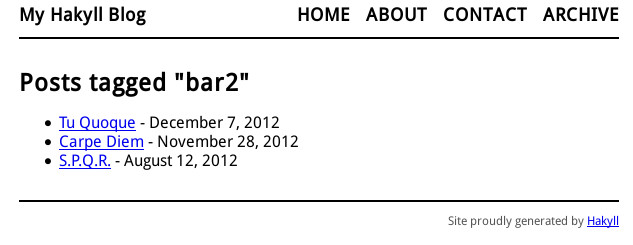Add tags to your Hakyll blog
As promised, here is a simple tutorial about adding tag supports to your Hakyll blog.
Few things before we start:
My Hakyll version used for this article is
4.4.3.2, other versions shouldn't have much difference.If this article looks too verbose, you can just look at bold sentences.
All the changes done below is contained in this archive. You can download, run it and skip rest of this article.
Let's start from scratch to keep it as simple as possible.
So we initialize a new Hakyll website.
# initialize the website under dir `mondo`
$ hakyll-init mondo
$ cd mondo
# compile the code necessary,
# in order to see the website.
$ ghc siteWrite tags in posts
To create tags, we should first learn how to add tags to our posts, this step is easy, look at the document for tags, it should begin with tags: followed with a comma-separated list.
Now, let's modify posts from mondo/posts:
mondo/posts/2012-08-12-spqr.markdown:
---
title: S.P.Q.R.
tags: foo, bar1, bar2
---mondo/posts/2012-10-07-rosa-rosa-rosam.markdown:
---
title: Rosa Rosa Rosam
author: Ovidius
tags: bar1
---mondo/post/2012-11-28-carpe-diem.markdown:
---
title: Carpe Diem
tags: bar2, foo
---mondo/posts/2012-12-07-tu-quoque.markdown:
---
title: Tu Quoque
author: Julius
tags: bar1, bar2
---Fetch metadata from our posts
Now we've assigned tags to the posts, next thing is to make them accessible from Haskell codes.
Before we go through all the posts and generate pages, we should build tags using buildTags.
Unforuntately this function is not well-documented, a short explanation would be : buildTags pattern makeId finds all tags from posts captured by pattern, converts each tag to a corresponding Identifier by using makeId and returns a value of type Tags.
From site.hs file, find these lines:
match "posts/*" $ do
route $ setExtension "html"
compile $ pandocCompiler
>>= loadAndApplyTemplate "templates/post.html" postCtx
>>= loadAndApplyTemplate "templates/default.html" postCtx
>>= relativizeUrlsInsert the following code in front of it:
The code region above says: find all tags by searching the metadata of posts found by pattern posts/*, and the corresponding path for each tag will be of form tags/*.html. (e.g. for tag foo, you can generate a list of all posts that contains tag foo under URL: {your-website}/tags/foo.html.)
After tags are generated, we need to tell the post generator to include the corresponding tag informations for each tag, this is done by modifying postCtx. (for now you don't have to understand the detail of postCtx if you just want to setup up tags.)
Put the following definition somewhere in your site.hs, I choose to put it right after the definition of postCtx:
postCtxWithTags :: Tags -> Context String
postCtxWithTags tags = tagsField "tags" tags `mappend` postCtxAnd then change all the occurrence of postCtx inside the code region mentioned above.
After this change, the code region should look like:
-- build up tags
tags <- buildTags "posts/*" (fromCapture "tags/*.html")
match "posts/*" $ do
route $ setExtension "html"
compile $ pandocCompiler
>>= loadAndApplyTemplate "templates/post.html" (postCtxWithTags tags)
>>= loadAndApplyTemplate "templates/default.html" (postCtxWithTags tags)
>>= relativizeUrlsTemplate pages
Now we need to add some changes to our templates, to make tags visible.
I think the following changes in this section are self-explanatory even if you knows nothing about how template works. So Let's go though them quickly.
Modify your templates/post.html to make it looks like:
<div class="info">
Posted on $date$
$if(author)$
by $author$
$endif$
</div>
<div class="info">
$if(tags)$
Tags: $tags$
$endif$
</div>
$body$Now we create the template for tag pages which lists all posts containing the corresponding tags. Since we already have a template for listing posts(template/post-list.html), we can simply reuse it.
This is done by creating a new file: templates/tag.html, with the following content:
Generate tag pages
This is the final step, we generate tag pages based on the templates we've written.
Put the following code somewhere after we build up tags, I choose to place it right after the line tags <- buildTags:
tagsRules tags $ \tag pattern -> do
let title = "Posts tagged \"" ++ tag ++ "\""
route idRoute
compile $ do
posts <- recentFirst =<< loadAll pattern
let ctx = constField "title" title
`mappend` listField "posts" (postCtxWithTags tags) (return posts)
`mappend` defaultContext
makeItem ""
>>= loadAndApplyTemplate "templates/tag.html" ctx
>>= loadAndApplyTemplate "templates/default.html" ctx
>>= relativizeUrlsNow it's done, recompile site.hs and have fun!
Result
Few screenshots after we adding tags:


I also provide the final version of mondo directory here.
Acknowledgement
Thanks for the big help from the source code of variadic.me.
